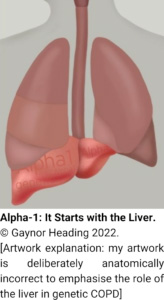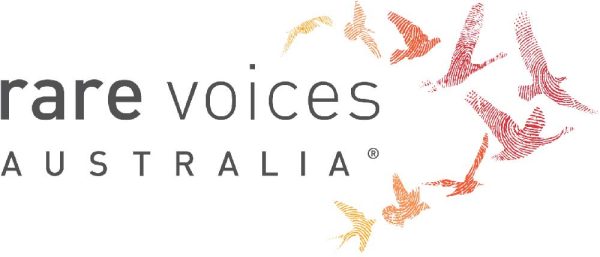Alpha-1 antitrypsin deficiency (A1AD)
Quick Search
- Summary
- Synonyms and Classifications
- Symptoms
- Disability Impacts
- Cause and Inheritance
- Diagnosis
- Treatment
- Clinical Care Team
- Clinical Care Guidelines
- Emergency Management
- Research
- Rare Disease Organisation(s)
- Lived Experience
- Support Services and Resources
- Mental Health
- Other Information
- Useful Links for Healthcare Professionals
Summary
Alpha-1 Antitrypsin Deficiency (A1AD) is a genetic condition associated with increased risk of chronic obstructive pulmonary disease (COPD), liver disease, skin conditions and inflammation of the blood vessels.1 Lung problems are common in adults with A1AD, whilst liver disease and skin conditions are observed in some adults and children. Some people living with A1AD do not have any symptoms.
A1AD is caused by genetic changes (variants) in the SERPINA1 gene.1,2 The SERPINA1 gene is responsible for making alpha-1 antitrypsin protein (AAT) in the liver. AAT is then sent to the lungs through the bloodstream to protect the lungs from damage.1 In A1AD, there is either no or insufficient AAT being made, or abnormal forms of the protein. Having no or low levels of AAT tends to cause more damage in the lungs, whilst abnormal AAT is more likely to affect the liver.2
Synonyms and Classifications
Synonyms: AATD; A-1ATD; AAT deficiency; alpha-1 antitrypsin deficiency; deficiency in Alpa-1-proteinase inhibitor; emphysema due to AAT deficiency; emphysema-cirrhosis, due to AAT deficiency; hemorrhagic diathesis due to antithrombin pittsburgh1
Universal rare disease classifications provide a common language for recording, reporting and monitoring diseases. Please visit the Rare Disease Classifications page for more information about these internationally recognised classifications.
Symptoms
Individuals with A1AD are more likely to have lung (pulmonary) disease (including emphysema, bronchitis, bronchiectasis and COPD) and liver disease (hepatitis, fibrosis, cirrhosis, hepatocellular carcinoma and liver failure).2 They may also be affected by issues associated with skin (panniculitis) and blood vessels (vasculitis).
Symptoms of A1AD may include shortness of breath and wheezing, repeated infections of the lungs and liver, jaundice, fatigue, rapid heartbeat when standing, vision problems and weight loss.1
It has been recommended that A1AD testing be considered for individuals with chronic airflow obstruction, adult-onset asthma, and bronchiectasis, particularly those under 40—45 years who are non-smokers or also have liver or skin disease.3,4
Children with A1AD may be born with liver damage or develop chronic liver disease during childhood.5 Symptoms and complications can include jaundice, insufficient weight gain, weight loss, enlarged liver (hepatosplenomegaly), enlarged spleen (splenomegaly), reduced or blocked flow of bile from the liver (cholestasis) and neonatal and chronic hepatitis.5
Please speak to your medical team to learn more about the symptoms and complications of A1AD.

Disability Impacts
Rare diseases are often serious and progressive, exhibiting a high degree of symptom complexity, leading to significant disability. Majority of the estimated two million Australians living with a rare disease meet the Australian Government’s definition for disability (in accordance to the Australian Public Service Commission and Australian Bureau of Statistics), and many experience severe and permanent disability impacts. If you or someone you care for is experiencing disability-related impacts from a rare condition, please speak with a health or disability professional for advice. Information about relevant disability support can be found at the RARE Portal’s Disability Support Information page.
Cause and Inheritance
A1AD is a genetic condition. It is caused by disease-causing genetic changes (variants) in the SERPINA1 gene that produces the AAT protein.1
Every individual has two copies (alleles) of the SERPINA1 gene, one on each chromosome inherited from each parent. A normal, non-disease-causing allele is referred to as the “M” allele.6 There have been reports of over 150 different genetic variants in SERPINA1 that can result in either abnormal or no AAT protein being produced, with the most common being called the “S” and “Z” alleles.6 Each individual can be either homozygous (have two of the same SERPINA1 alleles; e.g. “MM”, SS”, “ZZ” or others) or heterozygous (have two different alleles; e.g. “SZ”, “MZ”, “MS” or others). For people with A1AD, the risk and severity of their condition can be influenced by the type and combination of their SERPINA1 alleles.2
If you would like to learn more about the inheritance and impact of this condition, please ask your doctor for a referral to a genetic counsellor. Genetic counsellors are qualified allied health professionals who can provide information and support regarding genetic conditions and testing. More information about genetic counselling can be found at:
- Information on Genetic Services
- The National and State Services pages underneath the ‘Genetic Counselling’ sections listed
Diagnosis
Diagnosis of A1AD may be based on detection of low AAT levels in the blood and confirmed with genetic testing.4
More information about AAT tests can be found at Pathology Tests Explained: Alpha-1-antitrypsin.
Please speak to your medical team to learn more about the available diagnostic pathways for A1AD.
Treatment
There is currently no curative treatment for A1AD. Treatment is targeted at managing symptoms (symptomatic management) and involves a multidisciplinary care team.
For some individuals, augmentation therapy (intravenous infusions of AAT concentrate) may be used to increase AAT levels in the blood and lungs to treat A1AD-associated lung diseases.3 Augmentation therapy is approved for use in Australia by the Therapeutic Goods Administration (TGA) specifically for eligible individuals with a A1AD diagnosis, confirmed low levels of AAT and clinical evidence of emphysema; however, augmentation therapy is currently not subsidised by Medicare and can be costly.
It has been recommended that individuals with A1AD avoid exposure to cigarette smoke, dust and fumes and reduce their alcohol intake due to the associated risk of lung and liver diseases.2
Please speak to your medical team to learn more about the possible treatment or management options for your condition. Treatment will depend on an individual’s specific condition and symptoms. It is also important to stay connected to your medical team so that you can be made aware of any upcoming clinical trial opportunities.
Clinical Care Team
Clinical care for rare diseases often involves a multidisciplinary team of medical, care and support professionals. Please note that the information provided here is as a guide and that RVA does not necessarily monitor or endorse specific clinics or health experts.
In Australia, healthcare professionals involved in the clinical care of individuals with A1AD generally include general practitioners (GP), geneticists, pulmonologists, hepatologists and nephrologists. The need for different healthcare professionals may change over a person’s lifetime and extend beyond those listed here.
According to the International Classification of Diseases 11th Revision (ICD11), A1AD is classified as a metabolic condition. There may be clinical geneticists with experience in diagnosing and treating metabolic diseases, including A1AD.
Clinical Care Guidelines
We are not aware of any clinical care guidelines for A1AD in Australia. If you know of any relevant care guidelines, please let us know via the Contribute page.
In Australia, there is a position statement (from the Thoracic Society of Australia and New Zealand) available to provide information to clinicians on the diagnosis and treatment of A1AD (please note, this does not represent a guideline).
The following guidance is available from international experts outside Australia; however, there may be information that is not relevant or applicable to the Australian context, and may not be up to date:
- The Diagnosis and Management of Alpha-1 Antitrypsin Deficiency in the Adult is a statement of the Medical and Scientific Advisory Committee of the Alpha-1 Foundation (United States of America); published in 2016.
Emergency Management
Individuals living with rare diseases may have complex medical issues and disabilities, which are not always visible. It is often useful to refer to their medical history as well as personal information such as a medical card, doctor’s letter, or if available, a rare disease passport, for relevant information.
Research
There are specific considerations around participating in rare disease research, including clinical trials. It is important to be mindful of issues such as data privacy, research ethics, consent and differences in research regulations between Australia and other countries.
If you are interested in finding clinical trials for your condition, please visit the following websites; however, there may not be any clinical trials available:
It is best to discuss your interest in any clinical trials with your medical team to determine suitability and eligibility.
Please note that RVA does not necessarily monitor or endorse each group/organisation’s operational governance and activities.
Rare Disease Organisation(s)
Australian Organisations:
Alpha-1 Organisation Australia Inc.
Website: https://www.a1oa.org.au/
Alpha-1 Organisation Australia Inc. is a charity that provides support and advocacy for Alpha-1 Australians as well as promotes educational research aimed at advancing breakthroughs and ultimately finding a cure.
ALPHA-1 Association of Australia (AAA)
Website: https://www.alpha1.org.au/
Please note that RVA does not monitor or endorse each group/organisation’s operational governance and activities. When engaging with a group, please consider the information on the RARE Portal’s Finding Helpful Peer and Community Supports page.
Lived Experience
If you would like to share your personal story with RVA, please visit the Rare Voices Australia: Share Your Story page. RVA will consider your story for publishing on our website and inclusion on the RARE Portal.
Support Services and Resources
For information on available government and social services that provide support for individuals with a rare disease, please visit the National and State Services pages.
Mental Health
People living with a rare disease, including families and carers, often face unique challenges such as diagnostic delays, misdiagnoses, limited treatment options, and limited access to rare disease specialists and support. These challenges may impact people’s emotional wellbeing and quality of life. Many people find it helpful to seek mental health and wellbeing support to cope with ongoing stress and uncertainty. Connecting with people who have shared experiences through a support group may also be helpful. Information about relevant mental health and wellbeing support can be found at:
- Mental Health and Wellbeing Support for Australians Living with a Rare Disease
- The National and State Services pages underneath the ‘Mental Health’ sections listed
Other Information
Further information on A1AD can be found at:
- healthdirect: Alpha-1 Antitrypsin Deficiency
- Alpha-1 Organisation Australia Inc: Resources
- Lung Foundation Australia: Alpha1-antitrypsin Deficiency
- Genetic and Rare Diseases (GARD) Information Center: Alpha-1 Antitrypsin Deficiency
- National Organization for Rare Disorders (NORD): Alpha-1 Antitrypsin Deficiency
For more general information on lung, liver and kidney health, please visit:
Useful Links for Healthcare Professionals
- GeneReviews®: Alpha-1 Antitrypsin Deficiency
- Online Mendelian Inheritance in Man, OMIM®: #613490 Alpha-1 Antitrypsin Deficiency (A1ATD)
- Orphanet: Alpha 1 Antitrypsin Deficiency
- Human Phenotype Ontology (HPO): Alpha-1 Anti-trypsin Deficiency
- Royal College of Pathologists of Australasia (RCPA): Pathology Test – Alpha-1-antitrypsin
References
- Genetic and Rare Diseases (GARD) Information Center. Alpha 1-antitrypsin deficiency. Accessed 12 May 2022. https://rarediseases.info.nih.gov/diseases/5784/alpha-1-antitrypsin-deficiency
- Greene CM, Marciniak SJ, Teckman J, Ferraroti I, Brantly ML, Lomas DA et al. α1‑Antitrypsin deficiency. Nat. Rev. Dis. Primers. 2016;2:16051. https://www.nature.com/articles/nrdp201651
- Dummer J, Dobler CC, Holmes M, Chambers D, Yang IA, Parkin, L et al. Diagnosis and treatment of lung disease associated with alpha one‐antitrypsin deficiency: A position statement from the Thoracic Society of Australia and New Zealand*. Respirology. 2020; 25:321-335. https://doi.org/10.1111/resp.13774
- Pathology Tests Explained. Alpha-1-antitrypsin. Accessed 23 May 2022. https://pathologytestsexplained.org.au/learning/test-index/alpha1-antitrypsin
- Comba A, Demirbaş F, Çaltepe G, Eren E, Kalayci A. Retrospective analysis of children with α-1 antitrypsin deficiency. Eur. J. Gastroenterol. Hepatol. 2018; 30(7):774-778. https://doi.org/10.1097/MEG.0000000000001108
- Sandhaus RA, Turino G, Brantly ML, Campos M, Cross CE, Goodman K et al. The diagnosis and management of alpha-1 antitrypsin deficiency in the adult. Chronic Obst. Pulm. Dis. 2016; 3(3):668-682. http://doi.org/10.15326/jcopdf.3.3.2015.0182
Contributors
This page has been co-developed by Rare Voices Australia (RVA)’s RARE Portal team in consultation with Alpha-1 Organisation Australia Inc.
If you are aware of any additional information that may benefit stakeholders with an interest in this page, or if you notice any broken links or inaccurate information, please let us know via the Contribute page.

